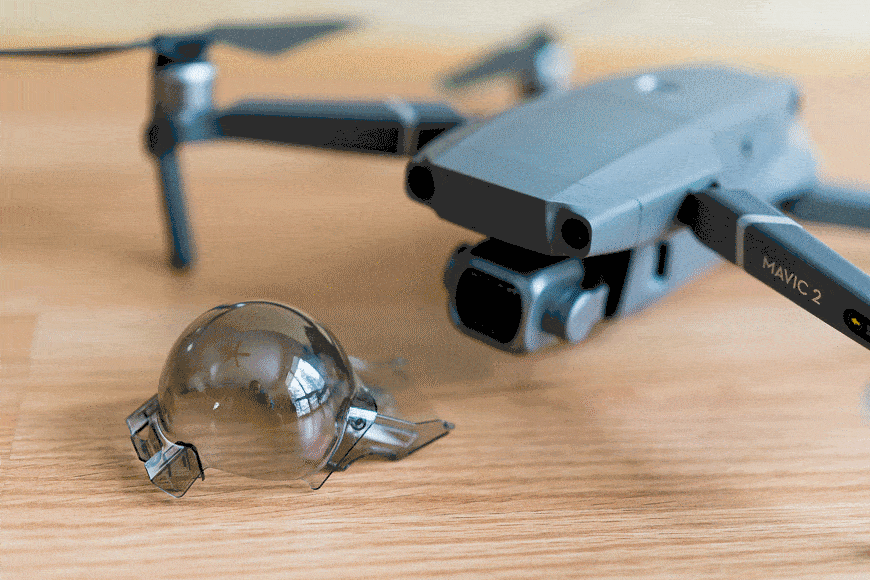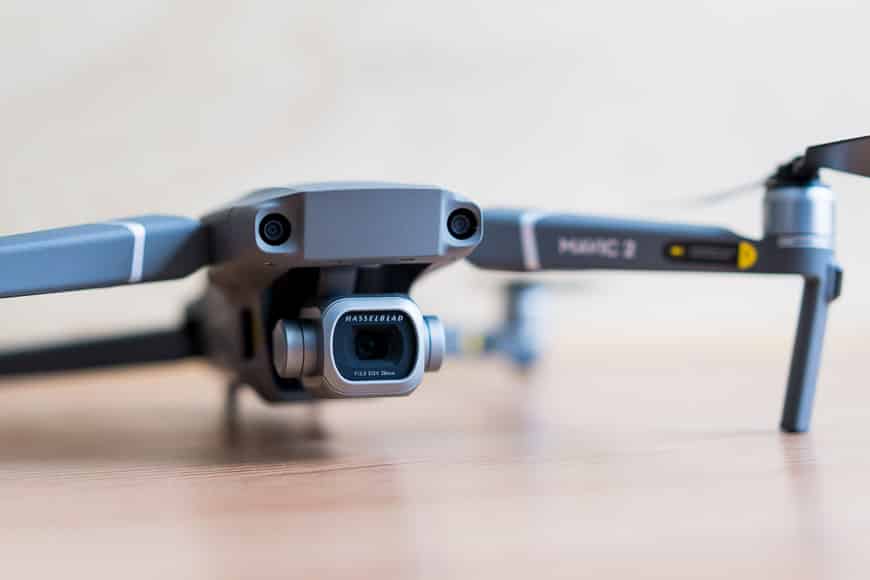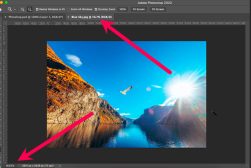
After recently becoming interested in aerial photography, I have been looking at what drone I should purchase. DJI seems to dominate the market and offers a number of appealing options at various price points.
As a professional photographer and relatively novice drone pilot, I was mainly concerned with image quality, affordability, ease of use, and functionality. I approached this article with the intent of finding the best drone for a newbie but wanting to maximize usability in my professional workflow.
My intent was to find a drone that would be able to make amazing images while remaining small, lightweight, and easy to use.


Lightweight and functional drone with impressive image quality and superior obstacle avoidance.
I wanted something I wouldn’t hesitate to throw in my bag. Something that had the ability to produce quality imagery but also not weigh me down or be difficult to use quickly.
(See the Mavic Mini review if you’re looking for something even smaller….)
My documentary style of photography makes it important to be as nimble and efficient as possible when creating.
This review is an assessment of what I think are the best value drones that DJI is currently making. There are a ton of options available (more and less expensive) but I wanted the best balance of performance and price.
With this in mind, I narrowed my search to three options – the DJI Mavic Pro, the DJI Mavic 2 Pro and the DJI Mavic 2 Zoom.
DJI Mavic Pro vs 2 pro vs Zoom Review
Image
Product
Features

DJI Mavic ProOUR #1 CHOICE View Price → 
DJI Mavic 2 ProHIGHLY RECOMMENDED View Price → 
DJI Mavic 2 ZoomGREAT VALUE View Price →
DJI Mavic Series Specs
DJI Mavic Pro
- Excellent value
- Almost all features on more expensive Mavic 2 Pro
- Very easy to use
- Compact Size/Weight
- Image quality / resolution is lacking
- Controls not as refined at Mavic 2 Pro
- Max Speed: 40 mph / 65 km/h
- Max Flight Time: 30min
- Obstical Avoidance: Downward, Forward
- Sensor: 1/2.3″ CMOS
- Aperture: f/2.2
- Focal length: 28mm Equivalent
- Resolution: 12 MP
- Weight: 1.64lb (704 g)
- Folded Dimensions L x H x W: 3.3 x 3.3 x 7.8″ / 83 x 83 x 198 mm
DJI Mavic 2 Pro
- Amazing image sensor (higher resolution 20MP)
- Excellent quality images
- Obstacle Avoidance on all sides
- Easy to fly
- More expensive
- Slightly bigger / heavier
- Max Speed: 44.7 mph / 72 km/h
- Max Flight Time: 31min
- Obstical Avoidance: Downward, Forward, Backward, Left, Right
- Sensor: 1″ CMOS
- Aperture: f/2.8 – f/11
- Focal length: 28mm Equivalent
- Resolution: 20 MP
- Weight: 2lb (907 g)
- Folded Dimensions L x H x W: 3.6 x 3.3 x 8.4″ / 91 x 84 x 214 mm
DJI Mavic 2 Zoom
- Zoom range of camera (24-48mm)
- Obstacle Avoidance on all sides
- Easy to operate
- Image quality / resolution is lacking
- Expensive for camera quality
- Max Speed: 44.7 mph / 72 km/h
- Max Flight Time: 31min
- Obstical Avoidance: Downward, Forward, Backward, Left, Right
- Sensor: 1/2.3″ CMOS
- Aperture: f/2.8-3.8
- Optical Zoom Range: 24-48mm Equivalent
- Resolution: 12 MP
- Weight: 2lb (907 g)
- Folded Dimensions L x H x W: 3.6 x 3.3 x 8.4″ / 91 x 84 x 214 mm
Build & Appearance

Shown here is the DJI Mavic Pro Zoom
When it comes to the build and appearance, there are some characteristics worth pointing out. First off, it is evident in the DJI Mavic Pro and the Mavic 2 Pro / Zoom are a generation apart.
With almost all cameras, the latest generation just feels a little better than the last one. This is true with the DJI Mavic Series. The design feels a little more refined and the ergonomics are slightly improved. The changes are minor and you wouldn’t notice unless you handled both generations.
The differences come down to a few minor details that are handy but not essential. One example is having a small amount of built in memory (8gb on the Mavic 2 Pro and Zoom) in case you forget to put in a micro SD card.
Another thing I noticed that was slightly improved was the one-piece design of the gimbal/camera cover on the Mavic 2 Pro and Zoom.
The original Mavic had a 2-piece design that is slightly more complicated to attach but almost feels a little more secure once in place.

Gimbal covers differ between Mavic models.
When it comes to the camera/gimbal, the Mavic 2 Pro shows an obvious design change. The much larger, square camera design looks (and performs) much better that the smaller Mavic Pro sensor.
Also visible is the Hasselblad branding which most people correlate with higher quality. Bigger is better in this case!
Most of the other design remains the same with minor look/feel differences that don’t really matter much when it comes to functionality.
Another thing to note is the Mavic 2 Pro and Zoom batteries are interchangeable but the original Mavic batteries are not compatible.
Overall, I don’t see much advantage of the Mavic Pro vs Mavic 2 Pro / Zoom when it comes to build and appearance. They are generally the same except when it comes to the camera specs.
Ergonomics & Handling

The ergonomics and handling of a drone are incredibly important, specifically the controller. A functionally designed controller can make or break the flying experience.
I did notice improvements in the design of the controller from the Mavic Pro to the Mavic 2 Pro / Zoom. The first main difference I noted was the improved packability of the newer controller.
The control sticks unscrew and stow in the controller making it easier to fit into a smaller space without worrying about breaking anything.
The other main handling difference came in the responsiveness of the controls. The Mavic 2 Pro / Zoom definitely has an advantage here. The improvements made it feel less jittery and smoother to do things like a pan or tilt maneuver that feels natural when recording video.
As I mentioned above, all three of these drones had similar handling/function in terms of the design of the drone itself. The Mavic 2 Pro and Zoom are slightly larger to accommodate a larger battery and added sensors etc.
The larger battery was great and I noticed a slight improvement in flight time. It would have been nice if the battery chargers were cross compatible but unfortunately they were not.
The other big improvement of the newer generation is the addition of 3 more proximity sensors. This helps dramatically in avoiding obstacles on all sides.
Most of the time I found myself flying in open spaces where I didn’t have to worry about crashing but the obstacle avoidance would be helpful if you are in a confined area or are new to flying drones.
Other minor changes to the design made the newer generation of Mavic a little more user-friendly. This includes the addition of a better smart phone mount on the controller.
These small gains are just minor improvements that come with the second generation of technology. It seems like DJI is really listening to user feedback and improving their designs.
While the newer generation has a few nicer features, the orginal Mavic Pro is a bit smaller, lighter, and more compact.
Autopilot Modes and Features

In general, these weren’t my top priority because I was mainly interested in creating still images but I thought they were worth mentioning. The Mavic 2 Pro / Zoom offers a number of upgraded flying modes and features that I found to be kind of cool.
When it comes to video and cool effects, the Mavic 2 Zoom offers the option of the Dolly Zoom. It’s a kind of warped looking effect you get by zooming in while flying backwards. This super-specialized feature was actually kind of fun to play with.
If you’re not into video, I think this highlights one of the cool things that the Mavic 2 Zoom offers in terms of photo opportunities. Almost every drone available up to this point has a fixed focal length lens (usually around a 28mm equivalent). That changed with the Mavic 2 Zoom.
The zoom lens offers a variable focal length from 24-48mm. This allows you to get wider than the Mavic 2 Pro and a little bit of lens compression in an image (making your subject appear closer to the background). I found this feature was only useful if you’re keeping your drone close to your subject.
If you like to fly way up in the sky and take big aerial views, you won’t see much use in the zoom feature because you can zoom by flying closer/further.
The other autopilot modes offered by the software are cool but mainly apply to shooting video (tap to fly, activetrack, etc). The effect that I did find useful was the gesture. It allows you to take a selfie by gesturing to the drone. It then waits three seconds for you to get in position and snaps a photo.
Overall, I didn’t see a lot of advantage of the Mavic 2 Pro over the Mavic Pro here unless you’re into the flexibility of having a zoom lens. If that sounds useful, definitely opt for the Mavic 2 Zoom.
One thing to note is that the Mavic 2 Zoom does sacrifice a bit on camera quality to achieve the zoom lens. The sensor is smaller and therefore, lower resolution. More on that below.
Camera Performance

Mavic 2 Pro | 1/15 f/2.8 ISO400
A clear winner in this category, the Mavic 2 Pro, offers a much larger sensor with better performance. I found the image quality on the Mavic 2 Pro to be much better than the Mavic 2 Zoom or Mavic Pro when it came to shooting in low light.
At almost double the size, it also has more resolution. The 20MP stills it produces are much more usable professionally than the 12MP stills offered by the Mavic 2 Zoom and Mavic Pro.
However, if you’re mainly looking at video, they all offer 4k shooting!
If you’re not shooting in low light, the Mavic Pro produces a very nice image. At 12MP it will still be completely adequate unless you’re planning to print the image large. Since images rarely get printed these days, I’d say the Mavic Pro could be a good savings here.
As I mentioned above, the main advantage of the Mavic 2 Zoom is the zoom range of the camera. As the only drone in its class with a zoom lens, it is a very unique offering. If you like the flexibility of changing focal lengths, this could be a great option.
Zooming can create a different look to the images that will definitely appeal to some people over the standard wide angle offerings of all the other drones.

Showing the variation in zoom between 24mm and 48mm on the Mavic 2 Zoom
One last benefit of the Mavic 2 Pro is the improved color science and dynamic range. The camera seems to have a bit better color than the others. I suspected this when I saw the larger sensor specs and Hasselblad branded camera but I also found it to be true when reviewing the files.
Overall, one of my main criteria was camera performance so I was very excited by the quality offered by the Mavic 2 Pro.
Overall Performance

Mavic 2 Zoom | 1/3200 f/3.8 ISO100
Overall, the three drones performed very similarly. Sure, there are some useful features and upgrades offered by the 2nd generation but I would say the only main differentiator was the camera.
The Mavic Pro was one of the best selling drones of all time and for good reason! Many people were amazed by this drone when it came out because of the ground breaking features it offers, all packed up in a portable unit.
Sure the new generation will have some improvements but I don’t think they are necessarily game-changers when it comes to functionality.
Only you can decide what the best drone is but I would not disregard the performance of the original Mavic Pro as a leader when it was introduced!
[Editor: I recommend the Mavic Pro Platinum, which is still more affordable than the Pro2/Zoom, but offers longer flight time and quieter operation than the original Pro. I upgraded from the Pro to the Platinum and couldn’t be happier!]
Value for Money
Determining what drone offers the best value is a tricky question. It is often a judgement call for the individual to make.
First off, you can’t deny that the Mavic 2 Pro offers amazing performance… but is it worth almost double the price of the original Mavic Pro?
The Mavic Pro gets you a lot of the same features at a great price! If you’re new to flying drones, I’d say opt for the Mavic Pro (or Pro Platinum). It will get you in the air at a lower price point and you can always upgrade later.
If you know that you’ll be flying it professionally and want the best when it comes to image quality, the Mavic 2 Pro is a clear winner.
The Mavic 2 Zoom is a bit of a tricky option to evaluate. I would say it is only a good value if you need a zoom lens, or will rely on the Dolly Zoom effect for video work… although this can usually be easily applied in post when editing the video footage.
It is a specialty item that offers one specific feature at a premium. Because of this, it sacrifices in other ways that would be beneficial if you didn’t need the zoom (larger sensor, high resolution, etc).
Overall, these are all amazing drones for the price. The technology is stunning and they are all amazingly easy to fly! It’s remarkable that you can get an aerial camera that takes great images for under $2,000!
Mavic 2 Pro vs Mavic Pro vs Mavic 2 Zoom Review | Conclusion
I think the best overall drone in this comparison comes down to value for money. If you’re looking to spend under $1,000, the Mavic Pro is the obvious choice. When your budget is closer to $1,500, I’d suggest the Mavic 2 Pro.
Features aside, the camera quality is the determining factor. If you want a Zoom camera (a specialty feature in my opinion), the Mavic 2 Zoom is your option.
With all that in mind, I’ll be getting the Mavic 2 Pro. It has the best combination of camera quality, functionality, and performance for my needs. I would say if you can afford the additional expense, this is a great choice.
Overall, I was impressed with all three of these drones. I was amazed at how easy to fly they all are and that anyone can get great photos and videos without much effort.
If you’re looking to get into aerial photography, all of the offerings from DJI listed in this article are amazing options! I think getting an elevated and unique perspective can re-ignite a passion for photography!
Sometimes all you need to spark new creativity is a new way to create images. The DJI drones did just that for me! I created the following short film on a recent road trip. Having the drones with me to get an aerial perspective made me excited to create and capture something in a new way!
Below is a summary of the likes and dislikes for each of the three drones in this review.
Regardless of what you choose to get, they will all make an excellent first foray into taking photos or videos with a drone!


Lightweight and functional drone with impressive image quality and superior obstacle avoidance.















